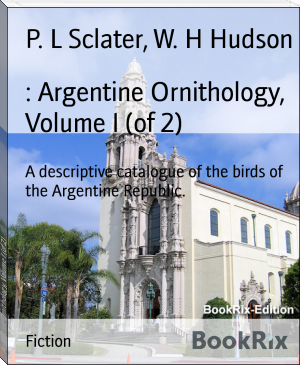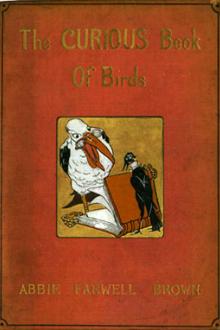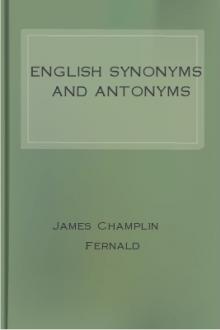: Argentine Ornithology, Volume I (of 2), P. L Sclater, W. H Hudson [best authors to read txt] 📗

- Author: P. L Sclater, W. H Hudson
Book online «: Argentine Ornithology, Volume I (of 2), P. L Sclater, W. H Hudson [best authors to read txt] 📗». Author P. L Sclater, W. H Hudson
+Sublegatus griseocularis+, _Scl. et Salv. P. Z. S._ 1870, p. 17
(Mendoza).
_Description._--Above cinereous; wings and tail dark ashy brown,
margins of wing-coverts and outer secondaries whitish; below, throat
and breast pale cinereous white; belly and under wing-coverts pale
lemon-yellow; bill horn-colour; feet dark brown: whole length 5·0
inches, wing 2·8, tail 2·5. _Female_ similar.
_Hab._ Southern Peru and Western Argentina.
Specimens of this species were obtained by Weisshaupt near Mendoza.
157. RHYNCHOCYCLUS SULPHURESCENS (Spix). (SULPHURY TYRANT.)
+Rhynchocyclus sulphurescens+, _Scl. et Salv. Nomencl._ p. 49;
_White, P. Z. S._ 1882, p. 607 (Misiones).
_Description._--Above olive-green, head washed with cinereous; lores
and line round the eye whitish; wings blackish brown, margined with
yellowish olive; tail dark brown, slightly edged with olive-green;
below sulphur-yellow tinged with olivaceous, throat more greyish;
middle of the belly rather brighter; under wing-coverts pale
sulphur-yellow; bill horn-colour; feet brown: whole length 5·2
inches, wing 2·6, tail 2·5. _Female_ similar.
_Hab._ S. America from Northern La Plata to Veragua.
Of this very widely diffused species specimens were obtained by White,
in June 1881, in the dense forests of Misiones.
158. PITANGUS BOLIVIANUS (Lafr.). (BIENTEVEO TYRANT.)
+Pitangus bellicosus+, _Scl. et Salv. Nomencl._ p. 50; _Durnford,
Ibis_, 1877, p. 178 (Buenos Ayres); _Gibson, Ibis_, 1880, p. 24
(Buenos Ayres); _White, P. Z. S._ 1882, p. 607 (Catamarca);
_Barrows, Bull. Nutt. Orn. Cl._ vol. viii. p. 200 (Entrerios).
+Saurophagus sulphuratus+, _Burm. La-Plata Reise_, ii. p. 452.
_Description._--Above brown; head black; front, superciliaries, and
line round the nape white; large vertical crest yellow, tipped
with black; wings and tail brown with rufous margins; beneath
sulphur-yellow, inner margins of wing- and tail-feathers pale
rufous; bill and feet black: whole length 8·0 inches, wing 4·2,
tail 3·3. _Female_ similar, but yellow crest not so much developed.
_Hab._ Bolivia, S. Brazil, Uruguay, and Argentina.
The Bienteveo is in its habits the most interesting member of the
Tyrannine family. It would be difficult to find two species more
dissimilar in disposition than are the Silver-bill, already described,
and the Bienteveo; the former being like an automaton, having only a few
set motions, gestures, and instincts, while the other is versatile in an
extraordinary degree, and seems to have studied to advantage the various
habits of the Kestrel, Flycatcher, Kingfisher, Vulture, and fruit-eating
Thrush; and when its weapons prove weak it supplements them with its
running. How strange it is that these two species, mentally as widely
separated as the Humming-bird and Crow, should be members of the same
family!
The Bienteveo has a wide range in South America, and inhabits the whole
of the Argentine country down to Buenos Ayres, where it is very common.
It is resident and lives in pairs, the sexes being always faithful. The
body is stout, somewhat large for a Tyrant-bird; the length being nine
and a half inches, including the beak, which is a little over an inch
in length. The wings are blunt and comparatively short, measuring, when
spread, fourteen inches. The head is large, and a broad, black band
extends from the beak its entire length, and above this is a pure white
stripe; the crown is black, concealing in its loose, abundant feathers a
brilliant yellow crest, which shows only when the bird is excited. The
upper plumage, including wings and tail, is pale brown; the entire under
surface sulphur-yellow. In both sexes the plumage is alike.
In Buenos Ayres the Bienteveo is found in every orchard and plantation:
it is familiar with man and invariably greets his approach with loud
notes--especially with a powerful three-syllabled cry, in which people
fancy there is a resemblance to the words Bien-te-veo ("I see you
well"); while its big head and beak, and strongly contrasted colours,
especially the black and white head-stripes, seem to give it a
wonderfully knowing look, as it turns its head from side to side to
examine the intruder. It is a loud-voiced garrulous bird, and has a
great range of sounds, from grating screams to long, clear, almost
mellow call-notes. It has one pretty habit, which brings out strongly
the pleasant feature in its character. Though the male and female are
greatly attached, they do not go afield to hunt in company, like the
Short-winged Tyrant, but separate to meet again at intervals during the
day. One of a couple (say the female) returns to the trees where they
are accustomed to meet, and after a time, becoming impatient or anxious
at the delay of her consort, utters a very long, clear call-note. He is
perhaps a quarter of a mile away, watching for a frog beside a pool, or
beating, harrier-like, over a thistle-bed, but he hears the note and
presently responds with one of equal power. Then, perhaps, for half an
hour, at intervals of half a minute, the birds answer each other, though
the powerful call of the one must interfere with his hunting. At length
he returns; then the two birds, perched close together, with their
yellow bosoms almost touching, crests elevated, and beating the branch
with their wings, scream their loudest notes in concert--a confused
jubilant noise that rings through the whole plantation. Their joy at
meeting is patent, and their action corresponds to the warm embrace of
a loving human couple.
I have frequently stood for the space of half an hour concealed amongst
the trees where a Bienteveo was calling to her mate, cheered at
intervals by the far-off faint response, for the pleasure of witnessing
in the end the joyful reunion of the two birds.
Except when breeding the Bienteveo is a peaceful bird, never going out
of its way to make gratuitous attacks on individuals of its own or of
other species; but in the pursuit of its prey it is cunning, bold,
and fierce. Like the true Tyrant-birds it preys a great deal on large
insects when they are abundant in the warm season, and is frequently
seen catching its prey in the air. A large beetle or grasshopper it
invariably beats against a branch before devouring it. But even in
summer, when insect prey is most abundant, it prefers a more substantial
diet whenever such is to be had. It frequently carries off the
fledglings of the smaller birds from their nests, in the face of the
brave defence often made by the parents. It is also fond of fishing, and
may be seen perched by the hour on a bank or overhanging branch beside a
stream, watching the water like a Kingfisher, and at intervals dashing
down to capture the small fry. In shallow pools, where there are
tadpoles and other prey, the Bienteveo does not mind getting a little
wet, but alights in the water and stands belly-deep watching for its
prey. I have seen a Bienteveo standing in the water in the midst of a
flock of Glossy Ibises. They are often seen, as Darwin remarks, hovering
like a Kestrel over the grass, and then dashing down to seize their
prey. Small snakes, frogs, mice, and lizards all minister to its
appetite, and with a capture of this kind it invariably flies to the
nearest stone or branch, against which it beats the life of its victim
out before devouring it. I once saw one fly out of some weeds carrying a
little wriggling snake of a very brittle species and about eight inches
long in its beak. Alighting on a gate it proceeded to kill its capture,
and at the first blow on the wood the snake flew into two pieces. A
mouse gives it a great deal of trouble, for after it has been killed it
cannot be devoured until reduced by repeated blows to a soft pulp, after
which it is with great labour pulled to pieces and eaten. Snails and
_Ampullariæ_ are also pounded until the shell breaks. In spring they
sometimes join the train of hooded gulls, guira cuckoos, cow-birds, and
various other kinds which follow the plough to pick up worms and larvæ;
but on the ground the Bienteveo is awkward in its motions, for it cannot
run like the Tyrant-birds with terrestrial habits, but only hops. At
estancia houses, when a cow is slaughtered, it comes in with the fowls,
milvago hawks, and dogs, for small pickings, being very fond of fresh
meat. It is a common thing to see a Bienteveo following a rural
butcher's cart, and waiting for an opportunity to dash in and carry off
any small piece of meat or fat it is able to detach. In the autumn they
feed very much on ripe fruit, preferring grapes, which they can swallow
whole, and figs, which are soft and easily eaten.
In its nidification the Bienteveo also departs widely from the, so to
speak, traditional habits of its congeners; for whereas most Tyrants
make small shallow nests, this species makes a very big elaborate domed
structure, and sometimes takes five or six weeks to complete it. It is
placed in a tree, without any attempt at concealment, and is about a
foot deep and eight or nine inches broad, and composed of a variety
of soft materials, chiefly wool. The entrance is placed near the top.
Outside, the nest has a very disorderly appearance, as there are always
long straws and sometimes rags hanging down; the cavity is deeply lined
with feathers, and is the _hottest_ nest I know. The eggs are five, very
long, pointed, cream-coloured, and spotted, chiefly at the large end,
with chocolate and purple.
159. MYIODYNASTES SOLITARIUS (Vieill.). (SOLITARY TYRANT.)
+Myiodynastes solitarius+, _Scl. et Salv. Nomencl._ p. 50; _Durnford,
Ibis_, 1877, p. 178, et 1878, p. 60 (Buenos Ayres); _White, P. Z.
S._ 1882, p. 607 (Salta); _Barrows, Bull. Nutt. Orn. Cl._ vol.
viii. p. 201 (Entrerios).
_Description._--Above grey, thickly covered with numerous black
shaft-spots; concealed vertical crest yellow; lores and sides of the
head black, superciliaries white; wings blackish, primaries slightly
edged with rufous, coverts and secondaries margined externally
with greyish white; tail blackish, with narrow external margins of
ferruginous; below greyish white, with numerous black striations;
belly and under wing-coverts tinged with yellowish and but slightly
striated; bill





Comments (0)